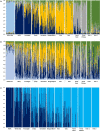Genomic analysis reveals neutral and adaptive patterns that challenge the current management regime for East Atlantic cod Gadus morhua L
- PMID: 33294016
- PMCID: PMC7691467
- DOI: 10.1111/eva.13070
Genomic analysis reveals neutral and adaptive patterns that challenge the current management regime for East Atlantic cod Gadus morhua L
Abstract
Challenging long-held perceptions of fish management units can help to protect vulnerable stocks. When a fishery consisting of multiple genetic stocks is managed as a single unit, overexploitation and depletion of minor genetic units can occur. Atlantic cod (Gadus morhua) is an economically and ecologically important marine species across the North Atlantic. The application of new genomic resources, including SNP arrays, allows us to detect and explore novel structure within specific cod management units. In Norwegian waters, coastal cod (i.e. those not undertaking extensive migrations) are divided into two arbitrary management units defined by ICES: one between 62° and 70°N (Norwegian coastal cod; NCC) and one between 58° and 62°N (Norwegian coastal south; NCS). Together, these capture a fishery area of >25,000 km2 containing many spawning grounds. To assess whether these geographic units correctly represent genetic stocks, we analysed spawning cod of NCC and NCS for more than 8,000 SNPs along with samples of Russian White Sea cod, north-east Arctic cod (NEAC: the largest Atlantic stock), and outgroup samples representing the Irish and Faroe Sea's. Our analyses revealed large differences in spatial patterns of genetic differentiation across the genome and revealed a complex biological structure within NCC and NCS. Haplotype maps from four chromosome sets show regional specific SNP indicating a complex genetic structure. The current management plan dividing the coastal cod into only two management units does not accurately reflect the genetic units and needs to be revised. Coastal cod in Norway, while highly heterogenous, is also genetically distinct from neighbouring stocks in the north (NEAC), west (Faroe Island) and the south. The White Sea cod are highly divergent from other cod, possibly yielding support to the earlier notion of subspecies rank.
Keywords: White Sea cod; chromosomes; haplotype maps; inversions; managements.
© 2020 The Authors. Evolutionary Applications published by John Wiley & Sons Ltd.
Figures







Similar articles
-
Geographic variation in gene flow from a genetically distinct migratory ecotype drives population genetic structure of coastal Atlantic cod (Gadus morhua L.).Evol Appl. 2022 Jun 21;15(7):1162-1176. doi: 10.1111/eva.13422. eCollection 2022 Jul. Evol Appl. 2022. PMID: 35899259 Free PMC article.
-
Analysis of coastal cod (Gadus morhua L.) sampled on spawning sites reveals a genetic gradient throughout Norway's coastline.BMC Genet. 2018 Jul 9;19(1):42. doi: 10.1186/s12863-018-0625-8. BMC Genet. 2018. PMID: 29986643 Free PMC article.
-
Two adjacent inversions maintain genomic differentiation between migratory and stationary ecotypes of Atlantic cod.Mol Ecol. 2016 May;25(10):2130-43. doi: 10.1111/mec.13592. Epub 2016 Apr 20. Mol Ecol. 2016. PMID: 26923504
-
Analysing migrations of Atlantic cod Gadus morhua in the north-east Atlantic Ocean: then, now and the future.J Fish Biol. 2013 Mar;82(3):741-63. doi: 10.1111/jfb.12043. J Fish Biol. 2013. PMID: 23464542 Review.
-
The northern shrimp (Pandalus borealis) offshore fishery in the Northeast Atlantic.Adv Mar Biol. 2007;52:147-266. doi: 10.1016/S0065-2881(06)52002-4. Adv Mar Biol. 2007. PMID: 17298891 Review.
Cited by
-
Phylogenomics and species delimitation of the economically important Black Basses (Micropterus).Sci Rep. 2022 Jun 6;12(1):9113. doi: 10.1038/s41598-022-11743-2. Sci Rep. 2022. PMID: 35668124 Free PMC article.
-
Adaptation to seasonal reproduction and environment-associated factors drive temporal and spatial differentiation in northwest Atlantic herring despite gene flow.Evol Appl. 2024 Mar 14;17(3):e13675. doi: 10.1111/eva.13675. eCollection 2024 Mar. Evol Appl. 2024. PMID: 38495946 Free PMC article.
-
A century of anthropogenic perturbations impact genomic signatures of the iconic migratory Atlantic cod.Sci Adv. 2025 Aug;11(31):eadp3342. doi: 10.1126/sciadv.adp3342. Epub 2025 Jul 30. Sci Adv. 2025. PMID: 40737403 Free PMC article.
-
Population and seascape genomics of a critically endangered benthic elasmobranch, the blue skate Dipturus batis.Evol Appl. 2021 Dec 7;15(1):78-94. doi: 10.1111/eva.13327. eCollection 2022 Jan. Evol Appl. 2021. PMID: 35126649 Free PMC article.
-
Geographic variation in gene flow from a genetically distinct migratory ecotype drives population genetic structure of coastal Atlantic cod (Gadus morhua L.).Evol Appl. 2022 Jun 21;15(7):1162-1176. doi: 10.1111/eva.13422. eCollection 2022 Jul. Evol Appl. 2022. PMID: 35899259 Free PMC article.
References
-
- Becker, R. A. , & Wilks, R. A. (2018). R‐package maps: Draw Geographical Maps. Retrieved from https://CRAN.R-project/package=maps
LinkOut - more resources
Full Text Sources

